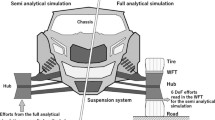Abstract
Numerical simulation of system dynamics is today a standard in the design of cars and trucks. The multibody system (MBS) analysis is applied to suspension kinematics and compliant kinematics, handling performance and ride comfort as well as to the generation of load data for lifetime prediction. These simulation tasks are carried out as an off-line simulation. Over the last couple of years the MBS method has been established in the real-time simulation domain, typically for the design of vehicle control systems and the test of electronic control units, using Hardware-in-the-Loop (HiL) simulation. This paper shows how the transition from offline multi-body-system (MBS) models to real-time simulation can be achieved automatically by using a component oriented reduction procedure for vehicle suspensions, which keeps the full component parameterization. This necessitates a transformation of the equations of motion from differential algebraic equations (DAE) into ordinary differential equations (ODE). For use in HiL-simulators the equations of motion with open interfaces of the applied forces and torques are provided to be integrated in a modular dynamic ride model.
Similar content being viewed by others
References
Kim, S. and Jung, H., Functinal Suspension Model for Real-Time Vehicle Dynamic Analysis. Proceeding on International Conference on Automotive Engineering, Dec. 10–13, 2001, Koogmin University, Seul Korea.
SIMPACK, http://www.simpack.com.
Schiehlen, W., Technische Dynamik, Teubner Studienbücher – Mechanik, 1986.
Rulka, W., Effiziente Simulation der Bewegungsgleichungen mechatronischer Systeme für industrielle Anwendungen, Dissertation an der TU-Wien 1998 bzw. DLR IB-532-01-06.
Baumgarte, J., ‘Stabilization of constraints and integrals of motion’, Comput. Meth. Appl. Mech. Eng. 1, 1–16, 1972.
Acevedo, M. and Celigüta, J.T., Real Time Dynamic Simulation of Passenger Cars, Mechanics of Structures and Machines, Proc. Mechatronics and Supercomputing Applications in the Transportation, pp. 559–566, 1994.
Tobolar, J., ‘The virtual axle – A simplified vehicle suspension model for real-time applications’, Computational Mechanics II, 2002, 461–468. University of West Bohemia in Pilsen, Nectiny, 2002.
Heppner, B., Durchgängige Lösung. RealTimes 1-2002, the ETAS news letter, 2002.
DSPACE, http://www.dspace.com
Pankiewicz, E., Rechnergestütztes Verfahren zur Generierung der Bewegungsgleichungen in Kraftfahrzeugen für Echtzeitanwendungen, BMW Group interner Bericht, 2001.
Rill, G., Simulation von Kraftfahrzeugen, Vieweg-Verlag ISBN 3-528-08931-8, 1994.
Author information
Authors and Affiliations
Corresponding author
Additional information
The work has been carried out during the employment of the author at INTEC GmbH, Argelsrieder Feld 13; 82234 Wessling, Germany; e-mail: intec@simpack.de
Rights and permissions
About this article
Cite this article
Rulka, W., Pankiewicz, E. MBS Approach to Generate Equations of Motions for HiL-Simulations in Vehicle Dynamics. Multibody Syst Dyn 14, 367–386 (2005). https://doi.org/10.1007/s11044-005-1144-8
Received:
Accepted:
Issue Date:
DOI: https://doi.org/10.1007/s11044-005-1144-8




